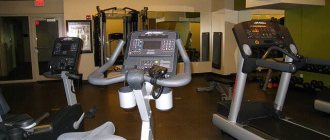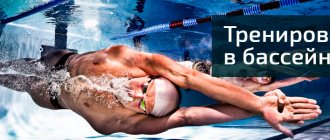There is a popular opinion among amateurs that you can only lose weight if you put in a lot of effort in training, sweat and suffer. And comfortable sports like swimming, yoga and Pilates will not help you lose weight.
It's a delusion. And today, together with Alexander Tarabrin, founder and leading coach of the Stars & Legends School, MSMK swimming and champion of Russia and Kazakhstan, we will figure out exactly how swimming will help you lose weight and tighten your figure. And at the end of the article you will find an approximate weekly training plan for beginner swimmers.
What is more effective: swimming, running or cycling?
Each sport has its own advantages and limitations. Running is good because it is accessible, allows you to change the intensity of the activity and control your well-being using your heart rate. However, this is a rather traumatic sport, and besides, overweight people should approach jogging especially carefully.
Cycling is an excellent cardio workout, plus joint exercises and no impact load. The disadvantage of this option is serious financial investments, as well as competent time management in order to have time to complete the workouts.
If you are interested in a more detailed comparison of these two sports, check out the article Which is better: running or cycling
As for swimming, it is a great fat burning option for literally everyone. Of course, we are not talking about ordinary swimming in a river or pool, but about purposeful swimming. In this case, calories will be burned more efficiently.
Example of calorie consumption depending on the athlete's weight and swimming style
Find out more about our weight loss programs:
The main thing is not to go to extremes. You cannot eat less than 800 kcal. The body will decide that hunger has begun and will slow down all metabolic processes. Losing weight will go slower. During the weight loss course, our specialists will tell you about all the intricacies of a healthy, balanced diet, teach you to listen to your body and explain how to combine physical activity with a new diet.
Why swimming is recommended for weight loss
In water, your body weight feels more comfortable; extra pounds provide buoyancy, which is good for starting training. It is dangerous to play many sports with too much weight due to the risk of injury, but swimming minimizes this risk.
During training, calories are consumed not only for the training itself, but also for maintaining a constant temperature in the water. Thus, about 100-150 extra calories per hour are lost even with minimal physical activity. The massage effect of water helps to avoid stretch marks, and the lymphatic drainage effect fights swelling.
However, it is important to understand that for comprehensive weight loss you need not just to swim, but to periodically change your pulse and exercise dynamics. To begin with, you can swim 2-3 times a week for 40 minutes at a comfortable pace, but for subsequent progress you need to change the load. This will speed up the process of losing weight, and will also help to avoid the body getting used to it and reaching a plateau effect.
marathon and half marathon training plans and start training today!
Losing weight will be especially effective if the training includes elements of all four swimming styles: crawl, breaststroke, dolphin and backstroke.
Read on topic: 20 reasons to go to the pool
WHAT ARE YOU DOING WRONG?!
Monotonous swimming is ineffective for losing weight.
First, let's remember how swimming training usually goes for most people. A person comes to the pool, takes a lane and swims monotonously at the same pace, alternating swimming styles, for example, breaststroke or freestyle. If a pool visitor comes to exercise in good company, then about 40% of the time will also be spent on communication. Such monotonous swimming is ineffective for losing weight! Of course, you will lose calories, strengthen muscles and improve your overall health. But to lose weight, you need to swim in a completely different way.
A properly selected swimsuit will help make your workouts more comfortable and highlight your figure! The model is wearing a shapewear swimsuit with Opal Wing C-Cups from Arena. Read more >>
Interval exercise forces the body to work in a different mode and speeds up metabolism.
And now we will tell you about interval training in swimming, with the help of which you will lose weight much faster. The essence of the interval training method is that you should alternate between working at your maximum capacity and resting (more precisely, swimming in an easy rest mode). Thanks to this workout, if done correctly, you will lose weight within two days after it! This happens due to the fact that interval exercise forces the body to work in a different mode and speeds up metabolism much more than a regular monotonous load. Thanks to accelerated metabolism, the process of losing weight is intensified. Plus, you'll also burn more calories during the workout itself. By the way, we talked earlier in this article about how to choose the right sports nutrition to lose weight.
If you are going to visit the pool regularly, take care of a quality cap and comfortable swimming goggles. The model is wearing best-selling Arena The One training glasses and an Arena Poolish Molded Cap.
How swimming affects your figure
If you start swimming as an adult, you shouldn't expect any fundamental changes in your figure. Women often fear that their arms and shoulders will become too large, but muscle hypertrophy from swimming in adulthood is impossible. To gain sculpted muscles, you need to supplement swimming with training on land, in the gym, and also increase the amount of protein in your diet.
Swimming tightens your abs, as the muscles work constantly, and even the deep abdominal muscles are pumped. You won’t be able to get six-packs just from swimming, but you can tighten your stomach and make it flatter.
How to swim to lose weight
The most energy-consuming style is the butterfly, but swimming as a dolphin is technically quite difficult. In addition, this style of swimming is mainly used for short series, and we need at least 40 minutes of training.
Therefore, we recommend combining styles, but choosing the crawl as the main one. It perfectly combines energy expenditure, working out all the muscles of the body and the possibility of long swimming.
- The more you use your legs, the more calories you burn. Try swimming 6 strokes of freestyle, double breaststroke (one stroke and two kicks) and you will immediately feel that it is much more difficult than regular swimming. In this case, the leg muscles are pumped well and calories are burned faster.
- Swim on your feet with a board, from 1 to 4 pools in a row depending on how you feel. Do 3-4 sets with a short rest of up to 40 seconds. If you feel confident, you can swim on your feet without a board, stretching your arms forward like an arrow and bringing them together in front of you.
If this exercise is difficult, put on fins and take a board. Swimmers usually love to swim this way because the exercise feels easy, but it also works the leg muscles and burns fat.
Source: totalimmersion.net
Next, try to accelerate in crawl swimming, using your legs as often as possible. Accelerate up to 25 meters, then do 25 meters at a comfortable pace to lower your heart rate. After every 100 meters, rest for 40 seconds. Do 3-4 reps.
And at the end, to relax and cool down, you can perform light crawl swimming with gliding fins.
- Swim intense segments at a fast pace for yourself with minimal rest (up to 30 seconds).
Start with a warm-up of 200-300 meters with calm, even breathing. Afterwards, make 4 segments of 25-50 m or 2 of 100, if you are already confident. The load level should be approximately 90% of the maximum.
Afterwards, swim for 200-400 meters depending on how you feel, you can wear fins or with a swimsuit, whichever will be easier and more comfortable for you. At the end there should be a feeling of complete restoration and relaxation.
- Long-term, high-volume workouts are great for burning fat. If you don’t feel strong enough yet, try individual elements of these workouts. You can add volumes approximately once a week by 10%, no more, so that smooth adaptation occurs.
Every 3-4 weeks, stop increasing the load or even reduce it a little so that the body has time to adapt and rest.
Volume training options:
- 800 meters crawl. You can first divide them into 8 x 100 or 16 x 50 with minimal rest.
- 1000 meters freestyle is already a confident indicator, try to swim it in one workout with a minimum number of stops.
- 2 x 1000 meters with a rest of 1-2 minutes.
- 2 x 1500 meters with a rest of 1-2 minutes and so on.
Bring the volume of continuous swimming to 20-60 minutes and perform one workout of each type per week: active legwork, intervals, long. You can also supplement each workout with various technique exercises: swimming on your side, swimming alternately on your right and left arm.
- Work at different intensities, alternate a smooth warm-up and cool-down with short accelerations of 10-15 meters at maximum speed, followed by a “breakdown” of up to 25/50 or 100 meters, depending on how you feel, as well as series at an above-average pace. After each series, be sure to restore a comfortable heart rate.
- Complement your swimming with flexibility training on dry land to burn more calories. General physical fitness of a swimmer on land - “dry swimming”, an effective interval non-stressful strength load, which will not only prepare the body for swimming, but also trigger a long-term calorie burning mechanism
- Don’t stagnate in your comfort zone, change your training regimen as soon as you feel accustomed to the loads.
Features of the classes
It's no secret how beneficial swimming in the pool is, because during such activities you get:
- Hardening. The water temperature in the pool fluctuates at 25-30 degrees, which promotes increased heat exchange, as a result of which the body hardens;
- Development of the respiratory and cardiovascular systems due to the pressure exerted by water;
- Unloading the joints and spine. During exercise, muscles and joints work in an intense mode, but the vertebrae are practically not subject to stress, so swimming can be practiced even as rehabilitation after injuries;
- Strengthening the muscle corset. As in any sport, thanks to strength training, in a short period of time you can get in shape and pump up your muscles;
- Hydromassage. While swimming, using various techniques, your skin receives a powerful hydromassage effect, thanks to which you can develop stagnant muscles, eliminate cellulite, varicose veins, and swelling;
- Weight loss. A very relevant idea for many is that with the help of swimming, you can adjust your weight. Such sports bring much greater results than exercises in the gym, since water has a higher density relative to air, which means that being practically weightless, we overcome heavy loads, practically without feeling it, and we can use many different techniques ;
- Improvement of general emotional state. This fact is a good addition to all of the above, because by doing physical activity and improving your health, you calm your nervous system and improve your mood.
You can start classes at any age; both children and the elderly can exercise in the pool. Moreover, inability is not a contraindication; anyone can learn. As a rule, this is nothing more than a psychological threshold, which experienced trainers working in the pool will help to cope with and teach.
Today, in almost every city there are dozens of institutions where you can practice swimming.
You can choose a pool based on recommendations from friends, read reviews on the Internet, or simply go to the place closest to your home. The most profitable thing is to buy a subscription and go by appointment, so as not to get into the group class schedule and adjust the time to your work schedule.
What to do with your appetite after exercise
You shouldn't eat too much after a workout, as well as before it. 2-3 hours before swimming you need to eat, but not heavily. A good idea would be a combination of complex carbohydrates (buckwheat or oatmeal, fruit) and protein (2 egg whites, low-fat cottage cheese, lean meat or fish).
After training, you can drink a portion of protein or take some protein food. Eat a hearty meal - after 1-2 hours, not earlier. This is not difficult to do in swimming, since after the pool you go to the shower and spend some time changing clothes and packing your things. So, unlike running, the likelihood of eating harmful carbohydrates immediately at the finish line is reduced.
The most important thing when losing weight is to maintain an overall calorie deficit.
Example of a weekly training program for beginners
It would be optimal to start with three workouts per week. For example, on Monday, Wednesday and Friday.
Monday
- 200 m warm-up: alternately 50 m breaststroke + 50 m arms breaststroke/legs crawl, with the legs working without pauses and the arms at a free pace.
- 200 m crawl leg in different body positions: 50 m on the chest + 50 m on the back + 50 m on the left and 50 m on the right side. You can replace this exercise with a crawl with a board.
- 200m crawl exercise 50m with each arm, starting position of the arm in front.
- 4x50m front crawl, rest 15-25 seconds.
- 4x15m accelerated front crawl at a good pace. After accelerating, calmly swim to the end of the pool.
- 400 m technique, average speed. Alternately 75m front crawl + 25m breaststroke.
- 100m free style, comfortable pace. It is necessary to recover.
Wednesday
- 200 m: alternately 50 m front crawl + 50 m back crawl.
- 200 m legs crawl on the back, arms in the “arrow” position.
- 4x50 m front crawl, kolobashka between the legs, it is advisable to inhale every 3 or 4 strokes with your arms.
- 100m breaststroke slide.
- 12x50m front crawl: alternately 25m at above average pace + 25m free crawl, after 30 seconds of rest.
- 300m crawl with board, feet in fins, soft footwork and free breathing.
- 100m free recovery swim in any style.
Friday
- 100m breaststroke slide.
- 100m backstroke.
- 100m front crawl.
- 400m front crawl: alternately 100m legs crawl + 100m arms crawl.
- 16x50m front crawl, average speed, but rest after every 50m for up to 15 seconds.
- 100m free recovery swim.











